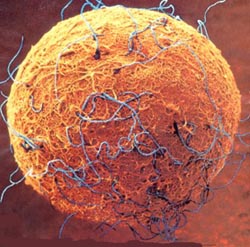Definition of ovum
The ovum (or egg cell, figure 1) is the mammalian female gamete (haploid cell), produced in the ovary through a process called oogenesis. This cell is characterized by being a giant cell that contains most of the constituents necessary to give rise to a new organism.

Figure 1 – Electron microscopy image of a female gamete, ovum.
Development of the ovum
At the end of meiosis, oocyte II gives rise to two unequal cells: one quite large, the mature ovum, and another small, the second polar globule. During the formation of the mature ovum, the oogenesis ends and the process of evolution of a new organism begins.
Fertilization
The entire process of fertilization occurs in the fallopian tubes and, in order to guarantee the success of this process, the maturation of oocyte II (obtained through meiosis) must be coordinated with the cell growth, the formation of the meiotic chromosomes and the reorganization nuclear. The success of fertilization is also dependent on the intimate contact between the sperm and the ovum and the fusion of their membranes – forming the zygote. This coordination is possible through intracellular signaling, which is crucial for the regulation of meiosis. Fertilization leads to oscillations in the intracellular concentrations of the calcium ion, which unlocks oocyte II (suspended in metaphase II) and leads to the progression of meiosis, and finally, the mature egg is formed.
After fertilization, the ovum is released from the ovary by a process called ovulation. At this stage, the genome of the cell is no longer controlled maternally and is controlled by the embryo itself. This process is possible due to mechanisms mediated by cyclic AMP-dependent protein kinases and coincides with the disappearance of the cell’s RNA reserves inherited from the mother. The time this process takes is based on the size of the poly-A tail of its mRNAs and varies from species to species (for example, in humans, mRNAs characteristic of the mother are not visualized from the 6-cell stage of the embryo).
References:
- Greenstein, D. (12 de 2005). Control of oocyte meiotic maturation and fertilization. WormBook, 28, 1-12.
- Heikinheimo, O., & Gibbons, W. E. (1998). The molecular mechanisms of oocyte maturation and early embryonic development are unveiling new insights into reproductive medicine. Molecular Human Reproduction, 4 (8), 745–756.
- Serrano, H., & Garcia-Suarez, D. (12 de 2001). Molecular aspects of mammalian fertilization. Asian Journal Andrology, 3, 243-249.




